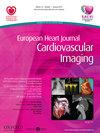Tricuspid annulus remodelling after transcatheter edge-to-edge repair for reduction of tricuspid regurgitation
引用次数: 0
Abstract
Abstract Funding Acknowledgements Type of funding sources: None. Background/Introduction Clinically relevant tricuspid regurgitation is a prevalent valvular disease that has a significant impact on survival. The remarkable progress made in cardiac imaging and in interventional cardiology in the last decades, permits today a better understanding of tricuspid valve and right ventricle morphology and pathophysiology. This allowed to develop multiple transcatheter devices for tricuspid valve interventions. Structural valve interventions are considered nowadays valuable treatment options in anatomically eligible patient at high surgical risk. Transcatheter tricuspid valve interventions are directed to increasing leaflet coaptation either directly by bringing the leaflets together (leaflet approximation devices) or indirectly by reducing the dilated annulus (annuloplasty devices). Efficacy and clinical outcome are promising, but the effect on right ventricle and tricuspid annular reverse remodelling is still under evaluation. Purpose Aim of the study is to evaluate the acute tricuspid annulus remodelling after percutaneous leaflet repair, using a leaflet approximation device for reduction of tricuspid regurgitation. Methods This is a retrospective dual-center cohort study that includes 22 consecutive patients, treated with TriClip in our Hospital. Tricuspid annulus geometry was evaluated using three-dimensional transoesophageal echocardiography examinations conducted during the procedure before and after Triclip implantation. The 3D data sets were analysed using the multiplanar reformatting method. Results The mean age of the study cohort was 80 years, and 90,9% were female. Tricuspid regurgitation was graded severe or greater at pre-operative examination in all patients, mostly due to annular dilation. Procedure was successfully in all patients, with at least 1-grade reduction of tricuspid regurgitation before hospital dismissal. A significative reduction of mean septal-lateral diameter (4,09 ± 0,45 cm vs 3,55 ± 0,57 cm, p = < 0,0001), mean major diameter (4,60 ± 0,56 cm vs 4,24 ± 0,58 cm, p = 0,0011), planimetric area (13,70 ± 2,68 cm2 vs 11,00 ± 2,49 cm2, p = <0,0001) and perimeter (13,50 ± 1,36 cm vs 12,40 ± 1,49 cm, p = 0,0001) of the tricuspid annulus was observed. The eccentricity index (obtained dividing septal-lateral by antero-posterior diameter) was 0,99±0,17 before TriClip implantation and 0,91± 0,19 after (p = 0,0336). Conclusions In this small real-world population, edge-to-edge repair using TriClip was found to be effective and safe. Tricuspid transcatheter repair with a leaflet approximation device lead also to a reduction in the tricuspidal annular dimensions. This is to date the first study that shows positive changes in tricuspid annular geometry, that could have potentially relevant therapeutic implications.经导管边缘到边缘修复后三尖瓣环重塑以减少三尖瓣反流
资金来源类型:无。临床相关的三尖瓣反流是一种常见的瓣膜疾病,对患者的生存有重要影响。在过去的几十年里,心脏成像和介入心脏病学取得了显著的进展,使得今天对三尖瓣和右心室的形态学和病理生理学有了更好的了解。这允许开发用于三尖瓣干预的多种经导管装置。结构瓣膜干预被认为是目前有价值的治疗选择,解剖符合条件的患者在高手术风险。经导管三尖瓣干预直接通过将小叶聚集在一起(小叶近似装置)或间接通过缩小扩张的环(环成形术装置)来增加小叶的适应。疗效和临床结果是有希望的,但对右心室和三尖瓣环反向重构的影响仍在评估中。目的探讨经皮小叶修复术后急性三尖瓣环重建,利用小叶近似装置减少三尖瓣反流的效果。方法回顾性双中心队列研究,纳入22例在我院接受TriClip治疗的连续患者。在Triclip植入前后,通过三维经食管超声心动图检查评估三尖瓣环的几何形状。采用多平面重格式化方法对三维数据集进行了分析。结果研究队列的平均年龄为80岁,其中女性占90.9%。所有患者术前检查时三尖瓣反流严重或加重,主要是由于环扩张。所有患者手术均成功,出院前三尖瓣返流至少降低1级。平均间隔外径显著减少(4.09±0.45 cm vs 3.55±0.57 cm), p = <观察三尖瓣环的平均大直径(4,60±0.56 cm vs 4,24±0.58 cm, p = 0.0011)、平面面积(13,70±2,68 cm2 vs 11,000±2,49 cm2, p = < 0.0001)和周长(13,50±1,36 cm vs 12,40±1,49 cm, p = 0.0001)。偏心率指数(以前后径划分中隔外侧)在TriClip植入前为0,99±0,17,植入后为0,91±0,19 (p = 0,0336)。结论:在这个小的现实世界人群中,使用TriClip进行边缘到边缘修复是有效和安全的。三尖瓣经导管修复与叶近似装置也导致减少三尖瓣环尺寸。这是迄今为止第一个显示三尖瓣环几何形状积极变化的研究,这可能具有潜在的相关治疗意义。
本文章由计算机程序翻译,如有差异,请以英文原文为准。
求助全文
约1分钟内获得全文
求助全文

 求助内容:
求助内容: 应助结果提醒方式:
应助结果提醒方式:


